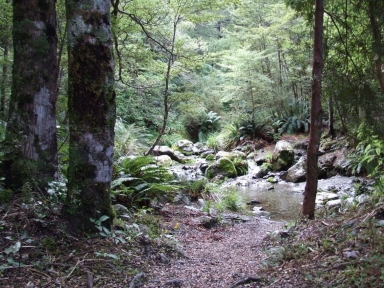Canterbury foothills forests

Beech/tawhai is the most common native forest in the Canterbury foothills. Black beech/tawhairauriki (Nothofagus solandri) dominates the lower slopes, while mountain beech/tawhairauriki (Nothofagus solandri var cliffortioides) is more prevalent at higher altitudes and on the more exposed harsh sites. Red beech/tawhairaunui (Nothofagus fusca) is also present, but is uncommon and found only in the Mt Grey area.
Podocarp species, such as kahikatea (Dacrycarpus dacrydiodes), mataï (Prumnopitys taxifolia), and rimu (Dacrydium cupressinum) are also present on the poorly drained lower slopes and moist gullies where they mix with beech. The understorey is diverse, and consists of a wide range of shrubs, herbaceous plants and fern species. The more common shrubs include species of Coprosma/karamū, lancewood/horoeka, broadleaf/kāpuka (Griselinia littoralis), putaputāwëtā (Carpodetus serratus), wineberry/makomako (Aristotelia serrata), and other Pseudopanax species.
Regenerating forest is also a feature of the Canterbury foothills flora and is represented by broadleaf, kōwhai (Sophora microphylla), small-leaved Coprosma species, mountain wineberry (Aristotelia fruticosa), mānuka (Leptospermum scoparium), and kānuka (Kunzea ericoides).
Southern rata (Metrosideros umbellata) is found sporadically, growing on bluffs and rock outcrops, especially in the Alford Forest.
Source: Native plants of Canterbury foothills forests : DOC and iNaturalist
See more detailed plant listing for Inland Basins
| Trees/Shrubs/Creepers/Climbers |
Grasses/Flaxes |
| Aristotelia serrata, makomako, wineberry |
Astelia fragrans, kakaha, bush lily |
| Carmichaelia petrii |
Astelia grandis |
| Carmichaelia torulosa (R) |
Austroderia richardii, toetoe |
| Carpodetus serratus, putaputäwëtä, marble leaf |
Carex buchananii, matirewa, cutty grass |
| Clematis paniculata |
Carex dipsacea |
| Coprosma areolata |
Carex punicea, uncinia rubra |
| Coprosma dumosa |
Carex secta, pukio |
| Coprosma grandiflora |
Carex tenuiculmis (R) |
| Coprosma 'Taylorii' |
Carex virgata, swamp sedge |
| Coprosma linariifolia |
Chionochloa rubra |
| Coprosma lucida |
Dichelachne crinita |
| Coprosma mircrocarpa |
Pentapogon crinitus |
| Coprosma propinqua, mingimingi |
Phormium cookianum, wharariki |
| Coprosma rhamnoides |
Phormium tenax, harakeke |
| Coprosma robusta, karamü |
Zotovia avenacea |
| Coprosma rotundifolia |
|
| Coprosma virescens |
|
| Cordyline australis, ti köuka, cabbage tree |
|
| Corokia cotoneater |
|
| Dacrycarpus dacrydioides, kahikatea, white pine |
|
| Dacrydium cupressium, rimu |
|
| Elaeocarpus hookerianus, pökäkä |
|
| Fuchsia excorticata |
|
| Fuscospora cliffortioides, mountain beech |
|
| Fuscospora fusca, tawhairaunui, red beech |
|
| Fuscospora solandri, tawhairauriki, black beech |
|
| Gaultheria antipoda |
|
| Griselinia littoralis, päpäuma, broadleaf |
|
| Hoheria angustifolia |
|
| Kunzea ericoides, kanuka |
|
| Leptecophylla juniperina |
|
| Leptospermum scoparium, manuka |
|
| Leucopogon fasciculatus |
|
| Lophomyrtus obcordata |
|
| Melicope simplex, poataniwha |
|
| Melicytus flexuosus |
|
| Melicytus ramifloris |
|
| Metrosideros umbellata, southern rätä, ironwood |
|
| Myrsine australis, matipou, mäpou |
|
| Myrsine divaricata, weeping mäpou |
|
| Olearia arborescens |
|
| Olearia avicenniifolia, mountain akeake |
|
| Olearia paniculata |
|
| Parsonsia capsularis |
|
| Parsonsia heterophylla |
|
| Pennantia corymbosa |
|
| Pittosporum eugenioides, tarata, lemonwood |
|
| Pittosporum tenuifolium, köhühu, black matipo |
|
| Podocarpus hallii, mountain tötara |
|
| Podocarpus totara |
|
| Prumnopitys ferruginea, miro |
|
| Prumnopitys taxifolia, mataï, black pine |
|
| Pseudopanax arboreus, whauwhaupaku, five finger |
|
| Pseudopanax colensoi, orihou, mountain five finger |
|
| Pseudopanax crassifolius, horoeka, lancewood |
|
| Pseudowintera colorata |
|
| Raukaua anomalus |
|
| Schefflera digitata |
|
| Sophora microphylla, köwhai |
|
| Veronica salicifolia, koromiko |
|
| Veronica traversii |
|
PLANT NAME (T = threatened, R = rare)

